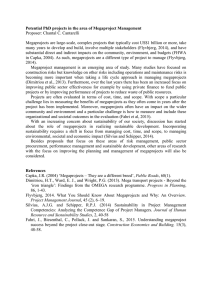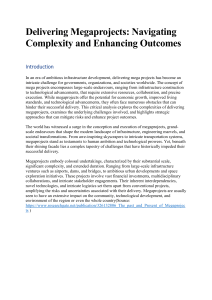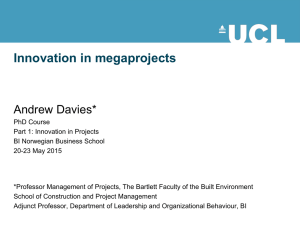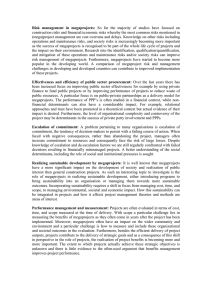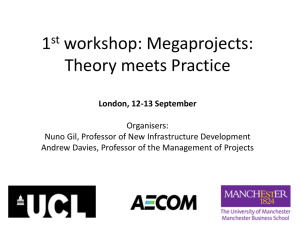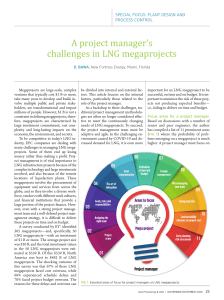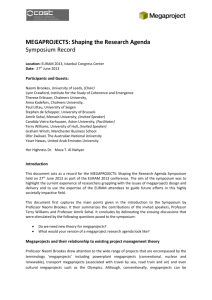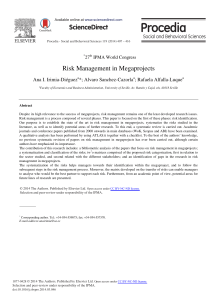Megaprojects - BI Norwegian Business School
advertisement
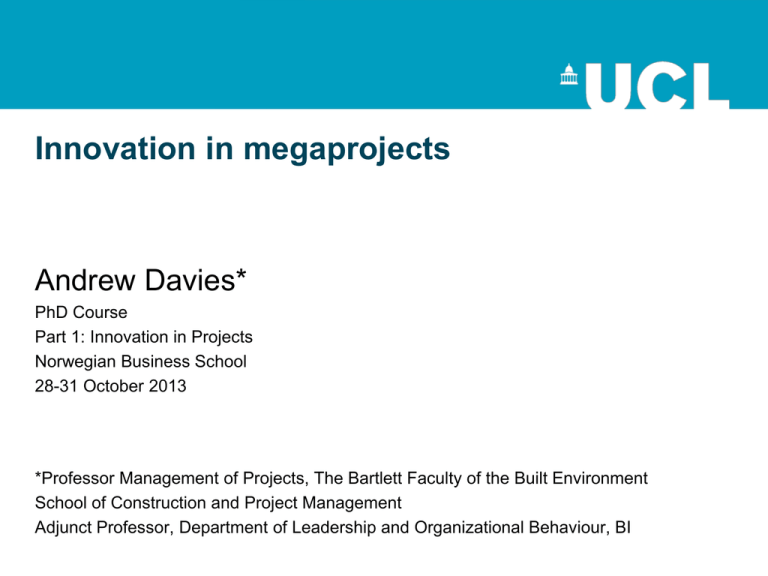
Innovation in megaprojects Andrew Davies* PhD Course Part 1: Innovation in Projects Norwegian Business School 28-31 October 2013 *Professor Management of Projects, The Bartlett Faculty of the Built Environment School of Construction and Project Management Adjunct Professor, Department of Leadership and Organizational Behaviour, BI • Megaprojects • Megaprojects: complex and uncertain • Group work: innovation in megaprojects What are megaprojects? • Large-scale infrastructure is designed and delivered as megaprojects of $1bn or more (Flyvbjerg et al, 2003) – “Productivity paradox”: despite growth in number and opportunities to learn, projects often fail • Megaproject organisation: – Large temporary coalition of suppliers – Led by large client, prime contractor or joint venture – Process tailored to the requirements of the project • Opportunity to find new ways to improve performance – Success depends on new and innovative ways to manage uncertainty and complexity Megaprojects: poor performers • RAND study of 52 major projects: average cost overrun 88%, only 50% performing as expected • Channel Tunnel – Construction completed in 1994, £4.9bn, 80% over budget • Boston “Big Dig” – Scheduled for completion in 1998 at $2.8bn – Opened in 2007 at a cost of over $14.6bn • Denver’s $5bn international airport – Nearly 200% cost overrun Megaprojects – poorly understood phenomenon • Infrastructure delivery, operation and finance is becoming a “business” – Private sector involvement UK privatisation of utilities, airports, ports and railways since 1979 – Private Finance Initiative (PFI) Public Private Partnerships (PPP) – Contracting out and outsourcing of public sector tasks • “Surprisingly, however, infrastructure has still received limited attention in management studies” (Gil & Beckman CMR 2009) • Megaprojects • Megaprojects: complex and uncertain • Group work: innovation in megaprojects Using Shenhar and Dvir’s (2007) model to understand megaprojects • Megaproject is a case of a complex and uncertain project • Contingency theory: critique of “one size fits all thinking” • 1 dimension – Shenhar (1993) 4 types of technological uncertainty • 2 dimensions – Shenhar (1996, 2001) tech uncertainty and 3 levels of complexity • 4 dimensional construct – Shenhar and Dvir (2007) Technology Super-high-tech High-tech Complex project (e.g. Apollo Moon landing; Challenger Space Shuttle) Medium-tech Low-tech Complexity Array System Assembly Platform Derivative Breakthrough Novelty Regular Fast/competiti ve Time-critical Blitz Pace Simple project (e.g. implement existing radio base station; IT system) 3 levels of complexity Array project System project Assembly project • ‘System of systems’ • systems with independent functions, but each with common goal Airport • Channel Tunnel • New nationwide mobile communications system • single system - a common goal • platform with subsystems • Aircraft • Air traffic control system • Building • self-contained component • perform a function in a larger system • Modular components and subassemblies • Computer stations Complexity and organisation • Assembly projects • • Single organisation (often one functional group), with the help from other functions Small team working in one location • System projects • • Main contractor responsible for deliver of product Tasks divided among several subcontractors, in-house or external • Array projects • • • Central umbrella organisation – often separate entity or company and formally coordinates programme and subprojects Deals with financial, logistical, legal and political issues Projects often spread over wide geographical area Systems integration Operator and users Design and integrate hardware, software and services into functioning system Systems integrator Subsystem suppliers Component suppliers Parts suppliers Systems integrator • Organisation with the capabilities to coordinate the design, integration of components and subsystems – Client – involved in several projects – Prime contractor – Joint venture • Creates a process to coordinate a large network of suppliers Uncertainty and contractual approach Fixed-price contract Cost-plus contract • • • Risk and opportunity shared by client & contractor Client bears the cost of development and seeks to avoid less than optimal solutions Contractor has an incentive to produce best result and maintain profits • Contractor takes on all the risk • Does not work well for high-tech uncertainty – creates risk for client & contractor • Contractor loses money due to unexpected events • Client gets inadequate product when contractor stays within the price range Relative uncertainty High Low • Megaprojects • Megaprojects: complex and uncertain • Group work: innovation in megaprojects Group work: innovation in megaprojects Each group examines the three cases: Heathrow Terminal 5, London Olympics and Crossrail Each group answers the following questions: 1.Describe the main characteristics of the megaproject (e.g. systems integrator, organisation, etc) 2.What are the main innovation challenges? 3.What are the main similarities and differences across the projects? Literature: – – – 2.2 Project-based production: complex products and systems 3.3 Megaprojects 5.1. Systems integration Heathrow Terminal 5 1. What are the main characteristics of the megaproject? 2. What are the main innovation challenges? London Olympics Crossrail
